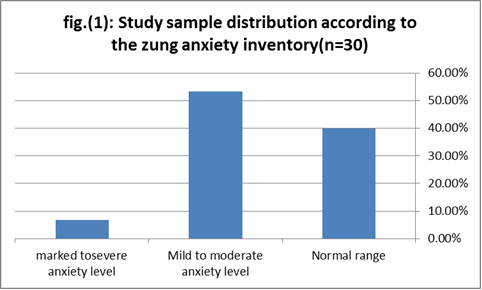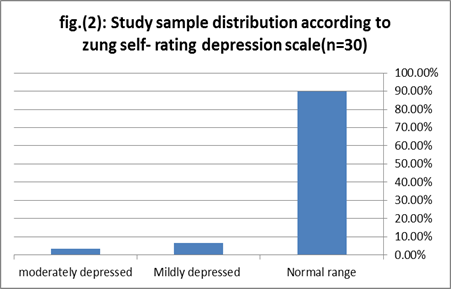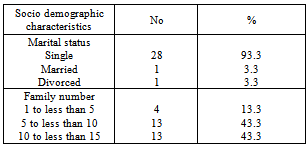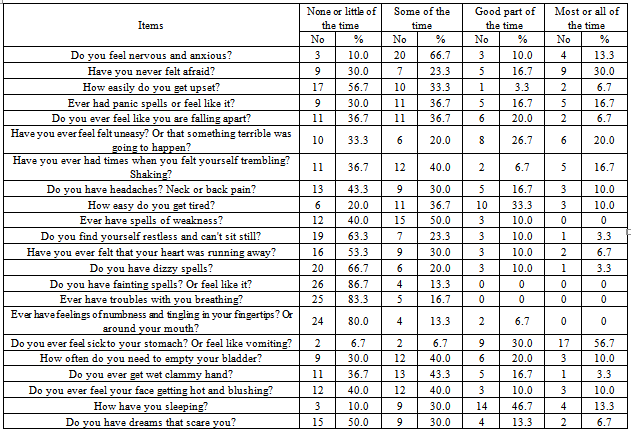-
Paper Information
- Previous Paper
- Paper Submission
-
Journal Information
- About This Journal
- Editorial Board
- Current Issue
- Archive
- Author Guidelines
- Contact Us
International Journal of Psychology and Behavioral Sciences
p-ISSN: 2163-1948 e-ISSN: 2163-1956
2012; 2(6): 277-281
doi: 10.5923/j.ijpbs.20120206.12
Evaluating Nursing Students' Anxiety and Depression during Initial Clinical Experience
Magda Mohamed Mohamed Bayoumi 1, Mona Mohamed Megahed Elbasuny 1, Amera Mohamed mofereh 2, Mona ali Mohamed assiri 2, Aeisha Hussen Al fesal 2
1Nursing Department, College of Applied Medical Sciences Mohail Asser, King Khalid University
2Student level, sex, Nursing Department, College of Applied Medical Sciences Mohail Asser, King Khalid University
Correspondence to: Magda Mohamed Mohamed Bayoumi , Nursing Department, College of Applied Medical Sciences Mohail Asser, King Khalid University.
| Email: |  |
Copyright © 2012 Scientific & Academic Publishing. All Rights Reserved.
Nursing students suffer high levels of stress and anxiety during their education experiences. Clinical training and first exposure in hospital clinical training field more stress than class experiences. The purpose of this study was to evaluate the perceived level of stress and anxiety in undergraduate nursing students. In this cross- sectional study, data were obtained from 30 students using a self-administered questionnaire The zung anxiety status inventory (ASI), zung self-rating depression scale. Prevalence of Normal range of depression level was 90%, mildly depressed 6.7% and moderately depressed about 3.3%. However the Zung anxiety status inventory reported only 6.7% of the student had marked to severe anxiety levels. Significant variation in anxiety status was evident with the anxiety scores were ranked as mild or moderate in 53.3% of students. These findings call for introduction of stress management programs and psychiatric care into nursing health services of the University.
Keywords: Keywards Anxiety, Depression, Nursing Students, Clinical Area
Cite this paper: Magda Mohamed Mohamed Bayoumi , Mona Mohamed Megahed Elbasuny , Amera Mohamed mofereh , Mona ali Mohamed assiri , Aeisha Hussen Al fesal , "Evaluating Nursing Students' Anxiety and Depression during Initial Clinical Experience", International Journal of Psychology and Behavioral Sciences, Vol. 2 No. 6, 2012, pp. 277-281. doi: 10.5923/j.ijpbs.20120206.12.
Article Outline
1. Introduction
- Stress has been identified as a 20th century disease and has been viewed as a complex and dynamic transaction between individuals and their environments[1]. Stress is a perceived concept, meaning that it can be caused by anything that one feels unbalances the harmony in life. Different types of stress produce anxiety, which results in feelings of apprehension that can ultimately lead to negative physical, emotional, cognitive and behavioural symptoms[2]. Anxiety and depressive mood are sometimes accompanied by modulation of neuroendocrine and immune functions[3].College students are at a high risk for increased stress, strenuous academic pressure and limited social and personal time can add to the normal life stressors and begin to be a negative effect[4].Nursing students and persons employed in the nursing profession have been identified as a population with an elevated stress level. Stressors for student nurses, identified by Beck & Srivastava, 1991[5], included adjusting to a rigorous program of theory, long hours of study and pressures of student clinical practice requiring emotional and personal maturity. The effects of stress on nursing students include somatic anxiety, psychic anxiety, depressive symptoms, cognitive symptoms, and negatively impacts on academic success[6]. Clinical experience has been always an integral part of nursing education. It prepares student nurses to be able "doing" as well as "knowing" the clinical principles in practice. The clinical practice stimulates students to use their critical thinking skills for problem solving[7].The Nursing student's experiences in their clinical practice provide greater insight to develop an effective clinical teaching strategy in nursing education and anxiety as a result of feeling incompetent, and lack of professional nursing skills and knowledge to take care of various patients in the clinical setting[8].The practicum portion of nursing education was identified by nursing students as more stressful than didactic courses. For nursing students these “real life” situations are stressful due to the fact that patients can be affected negatively or positively. The idea of causing harm, even death to a patient, is a fear for nursing students and nurses[9]. Initial clinical experiences (providing care, giving injections, communicating with clients, and performing physical exams) was reported as stressful[10].Clinical experience is a significant learning environment that presents challenges may cause nursing student experience anxiety. It is one of the most anxiety producing components of the nursing program which has been identified by nursing students. Lack of clinical experience, unfamiliar areas, difficult patients, fear of making mistakes and being evaluated by faculty members were expressed by the students as anxiety-producing situations in their initial clinical experience[11]. The aim of current study is to evaluate nursing student level of anxiety and depression during their initial clinical experience.
2. Methods
2.1. Research Design
- A cross-sectional study design will use.
2.2. Participants
- The study was conducted on total number of 30 female nursing students (Level Five), aged from 20 to 22 years during first semester 1432-1433H academic year.
2.3. Setting
- College of Medical Applied Sciences Mohali Asser- King Khalid University
2.4. Measurements
- Questionnaire (1): consisted of two parts; part (1) socio demographic data (age, marital status, number of family members). Part (2) the zung anxiety status inventory (ASI). It is a 20-item self-report assessment device which includes measures of state and trait anxiety. Answering the statements a person should indicate how much each statement applies to student. Each question is scored on a Likart-type scale of 1-4 (based on these replies: "a little of the time," "some of the time," "good part of the time," "most of the time"). Overall assessment is done by total score (Zung, 1974)[1].The total scores range from 20-80.● 20-44 Normal Range● 45-59 Mild to Moderate Anxiety Levels● 60-74 Marked to Severe Anxiety Levels● 75-80 Extreme Anxiety Levels.Questionnaire (2): consisted of two parts; part (1) socio demographic data (age, marital status, number of family members). Part (2) the zung self-rating depression scale (SDS). Is a short self-administered survey to quantify the depressed status of a patient. There are 20 items on the scale that rate the rating affective, psychological and somatic symptoms associated with depression.There are ten positively worded and ten negatively worded questions. Each question is scored on a scale of 1 through 4 (based on these replies: "a little of the time," "some of the time," "good part of the time," "most of the time").Scores on the test range from 20 through 80(Zung, 1965)[13]. The scores fall into four ranges:● 20-49 Normal Range.● 50-59 Mildly Depressed.● 60-69 Moderately Depressed.● 70 and above Severely Depressed.
2.5. Procedure
- Review of the current national and international related literature was done by the researcher; Data have been collected over a period of 2 months after approval has been obtained from Dean College of Medical Applied Sciences, Mohail Asser, King Khalid University.Data was collected in the first weeks of clinical application of two courses (maternity nursing and medical surgical nursing (1), each student completed two questionnaires individually.
2.6. Ethical Considerations
- Formal consent was issued from the College of Medical Applied Sciences- Mohail Asser, King Khalid University. Complete confidentiality of any obtained information was ensured. The researchers have also assured the administration that the conduction of the study will not affect the work in the study settings.
2.7. Statistical Method for Analysis
- Data entry analyzed using SPSS statistical software packages 0.18. Data presented using descriptive statistics in the form of frequencies and percentages for qualitative variables.
3. Results
- The study included 30 students, depression scale questions illustrated in Table 1 about 43.3% of them did report feeling hopeful about the future plus most of them feel they are useful and needed in nursing branch. so that, this finding explained the total score of depression scale which reported 90% of the sample study with in Normal range frequencies (Table 2).
|
|
|
 | Figure 1. Study sample distribution according to zung anxiety inventory (n=30) |
 | Figure 2. Study sample distribution according to zung self-rating depression scale(n=30) |
4. Discussion
- The nursing students clearly identified that the initial clinical experience is a cause of anxiety for them. There has been limited research on clinical stress, anxiety and depression among Arab population[14]. In this study, the majority of students had Mild to moderate anxiety levels. This was similar to the finding of Bell and Ruth who found that nursing students have a higher level of anxiety[15]. Most studies identified the clinical learning environment as primary source of nursing students' stress[16]. Another study[17] carried out on Egyptian baccalaureate nursing students, anxiety reported 46.6% and depression 27.9%. the difference May be related to different age and financial problems. Moreover Students feel anxious and this anxiety has effect on their performance[18].In a descriptive correlational study by Beck and Srivastava reported that second, third and fourth year nursing students reported that clinical experience was the most stressful part of the nursing program[5]. In study done by Hart and Rotem stressful events for nursing students during clinical practice have been studied. They found that the initial clinical experience was the most anxiety producing part of their clinical experience[19].Stressors identified by the students in this study such as self-reported anxiety and depression, increased in first exposure to clinical area and real situation are similar to what been described in previous studies of similar student groups[20]. Despite some similarity in the types of stressors identified on logistic regression analysis, High Stress was positively associated with number of stressors, and the global sickness index. A meta-analysis of 40 students on psychological distress among U.S. and Canadian college students explored the relationship between level of perceived stress and student distress[21]. Similarly to the study results which conclude that clinical area will be uneasy or that something terrible was going to happen.
5. Conclusions
- It is clear that the Saudi student nurses surveyed were exposed to identify the detrimental effects of clinical training stress on health and academic performance, college administrators should consider incorporating stress management training into orientation activities for nursing students. Other approaches may be the use of stress management, assertiveness skills, time management and counselling sessions, may be effective in reducing anxiety experienced by nursing students. More studies need to be considered at a multi-center level using more informative sociodemographic, psychosocial and institutional variables in order to confirm the present findings and to enlighten corrective interventions.
ACKNOWLEDGMENTS
- The authors would like to thank all the nursing students at the College of Medical Applied Sciences King Khalid University, Center of talent and creativity King Khalid University for supporting this project and Deanship of Student Affairs for their sincere cooperation.
 Abstract
Abstract Reference
Reference Full-Text PDF
Full-Text PDF Full-Text HTML
Full-Text HTML

